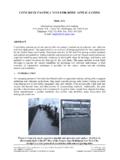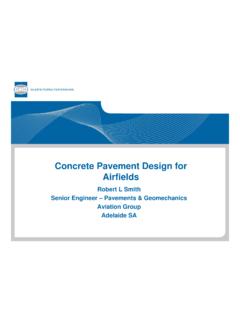Transcription of STANDARDS AND UPDATE FOR CONCRETE BLOCK PAVING …
1 8th International Conference on CONCRETE BLOCK PAVING , November 6-8, 2006 San Francisco, California USA STANDARDS AND UPDATE FOR CONCRETE BLOCK PAVING AND PAVING FLAGS IN THE UNITED KINGDOM Dr. Allan Dowson Allan Dowson Consulting 41 The Grove Hipperholme, Halifax West Yorkshire United Kingdom HX3 8JN Tel: +44 (0) 1422 201314, E-mail: SUMMARY This paper reviews the complete suite of STANDARDS produced by the British STANDARDS Institution for CONCRETE , clay and natural stone products. In 2005, several new and revised STANDARDS were produced and added to the existing range of the BS 7533 suite. The new STANDARDS introduced are: Part 7: Code of practice for laying setts and CONCRETE BLOCK PAVING . This standard incorporates rigidly laying BLOCK PAVING with plan sizes greater 200 mm x 100 mm. It includes the construction method of rigidly laying construction techniques for CONCRETE BLOCK PAVING .
2 Part 8: Guide to the structural design of lightly trafficked pavements of precast CONCRETE flags and natural stone slabs. Part 10: Guide for the structural design of trafficked pavements constructed of natural stone setts and CONCRETE BLOCK PAVING . This includes the design for rigidly laid CONCRETE BLOCK PAVING . Part 12: Guide to the structural design of trafficked pavements constructed of natural stone slabs and CONCRETE flags. This includes the design for rigidly laid flags. The revised STANDARDS are: Part 3: Code of practice for laying precast CONCRETE PAVING blocks and clay pavers for flexible pavements. This includes the methods of construction of porous pavements and the bedding and jointing requirements. Part 4: Code of practice for the construction of pavements of precast CONCRETE flags and natural stone slabs.
3 This standard details the three methods of laying flags on a sand bed, sand cement mortar and high strength quality mortar. 1. INTRODUCTION In 1901 the Institutions of Civil Engineers, the Chemical Engineers, Naval Architects and the Steel Institute created a committee to standardise iron and steel sections of bridges, railways and shipping. The Committee succeeded in cutting the production of different tram rails from 75 down to five. This saved industry about a million pounds the year. In 1929 the committee became the British Engineering STANDARDS Association and was granted a royal charter, which defined the association's objectives. A year later the Association became the British STANDARDS Institution. In 1946, in the aftermath of the Second World War, BSI was a founder member of the International Organisation for standardisation ISO and some years later, in 1964, was a founder member of the European equivalent CEN.
4 In 2001 5478th International Conference on CONCRETE BLOCK PAVING , November 6-8, 2006 San Francisco, California USA BSI celebrated its centenary and the year later signed a new memorandum of understanding with her Majesty's government. The standard is the published document that contains a technical specification or other precise criteria designed to be used consistently as a rule, guidelines, or definitions. STANDARDS help to make life simpler and to increase the reliability and the effectiveness of many goods and services we use. They are a summary of best practice and are created by bringing together the experience and expertise of all interested parties of producers, sellers, buyers, users and regulators having a particular material, product, process or service. They are designed for voluntary use and do not impose any regulations, however, laws and regulations may refer to certain STANDARDS and make compliance with them compulsory.
5 Any standard is a collective work. Committee consists of manufacturers, research organisations, government departments and consumers working together to draw up STANDARDS that evolve to meet the demands of society and technology. As the world's oldest national STANDARDS body, BSI has over 100 years' experience of bringing together these often very varied viewpoints and facilitating consensus. The use of STANDARDS is becoming more and more of a pre-requisite to worldwide trade. Although STANDARDS are designed for voluntary use and do not impose any regulations, by law many industry bodies and trade associations require product to conform to a British Standard or European directives before they can be offered for sale in the UK or EU. STANDARDS are essential to trade to increase the lead competitive markets.
6 They should insure any business offering products and services and process is cost-effective and time efficient and, commercially viable, credible, safe. Above all, any business, large or small, can benefit from the conformity and integrity of STANDARDS will bring. Having produced STANDARDS for the quality of the product, it was necessary to provide guidance in the form of a Code of Practice to enable users to lay the product in a prescribed manner. Trade Associations and along with the researchers had developed and produced methods of construction as early as the 1980s and to assist the designer the researchers along with industry developed methods of design primarily for CONCRETE BLOCK PAVING and flags. With the introduction of these design , the committee at BSI decided that it would be advantageous to have a suite of STANDARDS relating to CONCRETE BLOCK PAVING , CONCRETE flags CONCRETE kerbs, clay pavers and natural stone.
7 This was given a BS number BS 7533. Today, these suites of STANDARDS have in its range 13 different STANDARDS and are explained in the paper. 2. BS 7533 - SUITE OF STANDARDS BS 7533 - 1: 2001 Guide to the structural design of a heavy duty pavements constructed of clay PAVING blocks or precast CONCRETE PAVING blocks Scope This British Standard provides guidance on the design of flexible pavements surfaced with clay or CONCRETE BLOCK pavers manufactured in accordance with BS 6677-1 and BS 6717-1 respectively and 5488th International Conference on CONCRETE BLOCK PAVING , November 6-8, 2006 San Francisco, California USA laid in accordance with BS 7533-3. It applies to all pavements subjected to the usual road spectrum of axle loads up to 18 000 kg and trafficked by between million standard axles (msa) and 12 msa, including both highway pavements and industrial pavements where the traffic is similar in character to highway vehicles.
8 It specifically excludes heavy duty pavements with traffic exceeding 12 msa and other applications such as aircraft pavements and those in ports and specialized industrial areas. BS 7533 - 2: 2001 Guide for the structural design of light the trafficked pavements constructed of clay CONCRETE or precast CONCRETE PAVING blocks Scope This British Standard provides guidance on the design of lightly trafficked pavements surfaced with clay or CONCRETE BLOCK payers manufactured in accordance with BS 6677-1 or BS 6717-1 respectively and laid in accordance with BS 7533-3. It applies to all paved areas subjected to the usual road spectrum of axle loads up to 11000 kg and trafficked by up to million cumulative standard axles (msa), cnls-de-sac, driveways,car parks, precincts, lightly tyrafficked roads and paved areas.
9 BS 7533 - 3: 2005 Code of Practice for laying precast CONCRETE PAVING blocks and clay pavers for flexible pavements Scope This part of BS 7533 gives recommendations for the laying of conventional and permeable pavements using precast CONCRETE PAVING blocks conforming to BS EN 1338 and clay pavers conforming to BS EN 1344. This standard is intended for flexible pavements for roads, industrial areas and other paved surfaces subjected to all categories of static and vehicular loading and pedestrian traffic. The principles iven apply to all shapes and sizes of PAVING units covered by BS EN 1338 and BS EN 1344. g BS 7533 - 4: 2006 Code of practice for the construction of pavement of precast CONCRETE flags or natural stone slabs Scope This part of BS 7533 gives recommendations for laying precast CONCRETE flags conforming to BS EN 1339 and natural stone slabs conforming to BS EN 1341 intended for use in the construction of carriageways, footways, pedestrian areas and pavements for rigid and flexible construction for the ifferent application as given in Table 5.
10 D BS 7533 - 6: 1999 Code of Practice for laying natural stone, precast CONCRETE and clay kerb units Scope This part of BS 7533 gives recommendations for laying natural stone and precast kerbs, channels, edgings and quadrants conforming to BS EN 1340, BS EN 1343 and clay kerbs conforming to BS EN 1344, intended for use in the construction of carriageways and footways. It also applies to combined drainage and kerb products, and linear drainage units. BS 7533 - 7: 2002 Code of practice for construction of pavements of natural stone setts and cobbles Scope 5498th International Conference on CONCRETE BLOCK PAVING , November 6-8, 2006 San Francisco, California USA This part of BS 7533 gives recommendations for the laying of natural stone setts and cobbles, and rigid construction with CONCRETE BLOCK PAVING intended for pavements, roads, industrial areas and other aved surfaces subjected to all categories of static and vehicular loading and pedestrian traffic.










